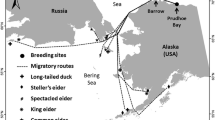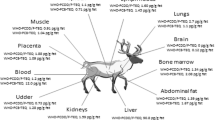Abstract
Although concentrations of organochlorine compounds (OCs) in birds from most of the United States and Canada have decreased over the last 30 years, there is still concern that migrant birds might be exposed to elevated concentrations of OCs during migration in Latin America. The Lerma-Chapala Basin in west-central Mexico is an important migration corridor and wintering area for many species. The objectives of this study were to assess if resident and migrant birds wintering in western Michoacán, Mexico accumulated elevated concentrations of OCs during fall and spring and to determine if the stable isotopes δ15N, δ13C, and δD could be used to predict burdens and origins of DDE accumulation. Resident and migrant passerine insectivorous birds were collected during fall and spring (2001–2002) in northwest Michoacán, near Chapala Lake, Mexico. The carcasses were analyzed for OCs and tail feathers were analyzed for stable isotopes δ15N, δ13C, and δD. The OCs detected in more than 50% of the samples were: oxychlordane (79%), p,p’-DDE (100%), p,p′-DDT (57%), and total PCBs (100%). p,p′-DDE was the OC detected at the highest concentrations, whereas residues of other OCs were near or below detection limits. Overall, there were no significant differences in concentrations of OCs between seasons or between resident and migrant birds. Concentrations of DDE and oxychlordane were somewhat higher in migrant and resident birds during spring than in fall; however, concentrations were significantly different only for oxychlordane. Two resident birds collected in fall and spring had DDE residues >10 μg/g wet weight in carcass. There were no significant differences in δ13C and δ15N values among species, between seasons, or between migrant and resident birds. However, δD values were clearly different between species and helped differentiate migrant from resident birds. δD values also were negatively and significantly correlated with DDE concentrations in carcass. Birds with more depleted δD values in feathers tended to have higher DDE concentrations than those with less depleted δD values, suggesting a potential latitudinal accumulation of DDE. Overall, our results suggest that during fall and spring, there is not a significant buildup of persistent OCs in migrant and resident passerine insectivorous birds in northwest Michoacán, Mexico.



Similar content being viewed by others
References
Bartuszevige AM, Capparella AP, Harper RG, et al. (2002) Organochlorine pesticide contamination in grassland-nesting passerines that breed in North America. Environ Pollut 117:225–232
Brooks JM, Wade TL, Atlas EL, et al. (1989) Analysis of bivalves and sediments for organic chemicals and trace elements. Third Annual Report for NOAA’s National Status and Trends program, Contract 50-DGNC-5-00262, Silver Springs, MD
Capparella AP, Klemens JA, Harper RG, Frick JA (2003) Lack of widespread organochlorine pesticide contamination in South American resident passerines. Bull Environ Contam Toxicol 70:769–774
Chamberlain CP, Blum JD, Holmes RT, Feng X, Sherry TW, Graves GR (1997) The use of isotope tracers for identifying populations of migratory birds. Oecologia 109:132–141
Chanon KE, Mendez-Galvan JF, Galindo-Jaramillo JM, Olguin-Bernal H, Borja-Aburto VH (2003) Cooperative actions to achieve malaria control without the use of DDT. Int J Hyg Environ Health 206:387–394
DeNiro MJ, Epstein S (1978) Influence of diet on the distribution of carbon isotopes in animals. Geochim Cosmochim Acta 42:495–506
Elliott JE, Morrissey CA, Henny CJ, Ruelas Insunza E, Shaw P (2007) Satellite telemetry reveal contaminant sources to Pacific northwest ospreys. Ecol Applic 17:1223–1233
Fertilizantes Mexicanos SA (1981) Plan de desarrollo de Fertimex en la producción, formulación y comercialización de insecticidas Vol II. Gerencia general de Programación y Desarrollo, Mexico, DF
Harper RG, Frick JA, Capparella AP, et al. (1996) Organochlorine pesticide contamination in neotropical migrant passerines. Arch Environ Contam Toxicol 31:386–390
Harris ML, Wilson LK, Elliott JE, Bishop CA, Tomlin AD, Henning KV (2000) Transfer of DDT and metabolites from fruit orchard soils to American Robins (Turdus migratorius) twenty years after agricultural use of DDT in Canada. Arch Environ Contam Toxicol 39:205–220
Hobson KA, Wassenaar LI (1997) Linking breeding and wintering grounds of neotropical migrant songbirds using stable hydrogen isotopic analysis of feathers. Oecologia 109:142–148
Hobson KA, Atwell L, Wassenaar LI (1999) Influence of drinking water and diet on the stable hydrogen isotope ratios of animal tissues. Proc Natl Acad Sci USA 96:8003–8006
Howell SNG, Webb S (1995) A guide to the birds of Mexico and northern Central America. Oxford University Press, New York
Hutto RL (1986) Migratory landbirds in western Mexico: a vanishing habitat. West Wildlands 11:12–16
Klemens JA, Harper RG, Frick JA, Capparella AP, Richardson HB, Coffey MJ (2000) Patterns of organochlorine pesticide contamination in neotropical migrant passerines in relation to diet and winter habitat. Chemosphere 41:1107–1113
Klemens JA, Wieland ML, Flanagin VJ, Frick JA, Harper RG (2003) A cross-taxa survey of organochlorine pesticide contamination in a Costa Rican wildland. Environ Pollut 122:245–251
Lind OT, Dávalos-Lind LO (2002) Interaction of water quantity with water quality: the Lake Chapala example. Hydrobiologia 467:159–167
Lott CA, Smith JP (2006) A geographic-information-system approach to estimating the origin of migratory raptors in North America using stable hydrogen isotope ratios in feathers. Auk 123:822–835
Marra PP, Hobson KA, Holmes RT (1998) Linking winter and summer events in a migratory bird by using stable-carbon isotopes. Science 282:1884–1886
McCutchan JH, Lewis WM, Kendall C, McGrath CC (2003) Variation in trophic shift for stable isotope ratios of carbon, nitrogen, and sulfur. Oikos 102:378–390
Meehan TD, Giermakowski JT, Cryan PM (2004) GIS-based model of stable hydrogen isotope ratios in North American growing-season precipitation for use in animal movement studies. Isotopes Environ Health Stud 40:291–300
Mora MA (1997) Transboundary pollution: persistent organochlorine pesticides in migrant birds of the southwestern United States and Mexico. Environ Toxicol Chem 16:3–11
Mora MA, Anderson DW, Mount ME (1987) Seasonal variation of body condition and organochlorines in wild ducks from California and Mexico. J Wildl Manag 51:132-141
Mora MA, Boutton TW, Musquiz D (2005) Regional variation and relationships between the contaminants DDE and selenium and stable isotopes in swallows nesting along the Rio Grande and one reference site, Texas, USA. Isotopes Environ Health Stud 41:69–85
Mora MA, Musquiz D, Bickham JW, et al. (2006) Biomarkers of exposure and effects of environmental contaminants on swallows nesting along the Rio Grande, Texas, USA. Environ Toxicol Chem 25:1574–1584
Mora MA, Rourke J, Sferra S, King K (2003) Environmental contaminants in surrogate birds and insects inhabiting southwestern willow flycatcher habitat in Arizona. Stud Avian Biol 26:168–176
Mora MA, Skiles R, McKinney B, et al. (2002) Environmental contaminants in prey and tissues of the peregrine falcon in the Big Bend Region, Texas, USA. Environ Pollut 116:169–176
Mora MA, Skiles RS, Paredes M (2007) Further assessment of environmental contaminants in avian prey of the peregrine falcon in Big Bend National Park, Texas. Southwest Nat 52:54–59
Mora MA, Wainwright SE (1998) DDE, mercury, and selenium in biota, sediments, and water of the Rio Grande–Rio Bravo Basin, 1965–1995. Rev Environ Contam Toxicol 158:1–52
Morrissey CA, Bendell-Young LI, Elliott JE (2004) Linking contaminant profiles to the diet and breeding location of American dippers using stable isotopes. J Appl Ecol 41:502–512
Norris RD, Marra PP, Kyser KT, Sherry TW, Ratcliffe LM (2004) Tropical winter habitat limits reproductive success on the temperate breeding grounds in a migratory songbird. Proc R Soc London B 271:59–64
Pérez GE, Hobson KA (2007) Feather deuterium measurements reveal origins of migratory western loggerhead shrikes (Lanius ludovicianus excubitorides) wintering in Mexico. Divers Distrib 13:166–171
Rubenstein DR, Chamberlain CP, Holmes RT, et al. (2002) Linking breeding and wintering ranges of a migratory songbird using stable isotopes. Science 295:1062–1065
Sericano JL, Atlas EL, Wade TL, Brooks JM (1990) NOAA’s status and trends mussel watch program: chlorinated pesticides and PCBs in oysters (Crassostrea virginica) and sediments from the Gulf of Mexico, 1986–87. Marine Environ Res 29:161–203
Simonich SL, Hites RA (1995) Global distribution of persistent organochlorine compounds. Science 269:1851–1854
Tieszen LL, Boutton TW, Tesdahl KG, Slade NA (1983) Fractionation and turnover of stable carbon isotopes in animal tissues: Implication for δ13C analysis of diet. Oecologia 57:32–37
Wassenaar LI, Hobson KA (2003) Comparative equilibrium and online technique for determination of non-exchangeable hydrogen of keratins for use in animal migration studies. Isotopes Environ Health Stud 39:1–7
Yard HK, Van Riper C III, Brown BT, Kearsley MJ (2004) Diets of insectivorous birds along the Colorado River in Grand Canyon, Arizona. Condor 106:106–115
Acknowledgments
I appreciate the help with logistics and field assistance of J. Nava and M. A. Mejia of the Interdisciplinary Research Center for Integrated Regional Development (CIIDIR), Jiquilpan, Michoacán. This manuscript has benefited by comment from D. Papoulias, M. Woodin, and two anonymous reviewers.
Author information
Authors and Affiliations
Corresponding author
Rights and permissions
About this article
Cite this article
Mora, M.A. Organochlorine Pollutants and Stable Isotopes in Resident and Migrant Passerine Birds from Northwest Michoacán, Mexico. Arch Environ Contam Toxicol 55, 488–495 (2008). https://doi.org/10.1007/s00244-007-9124-z
Received:
Accepted:
Published:
Issue Date:
DOI: https://doi.org/10.1007/s00244-007-9124-z




